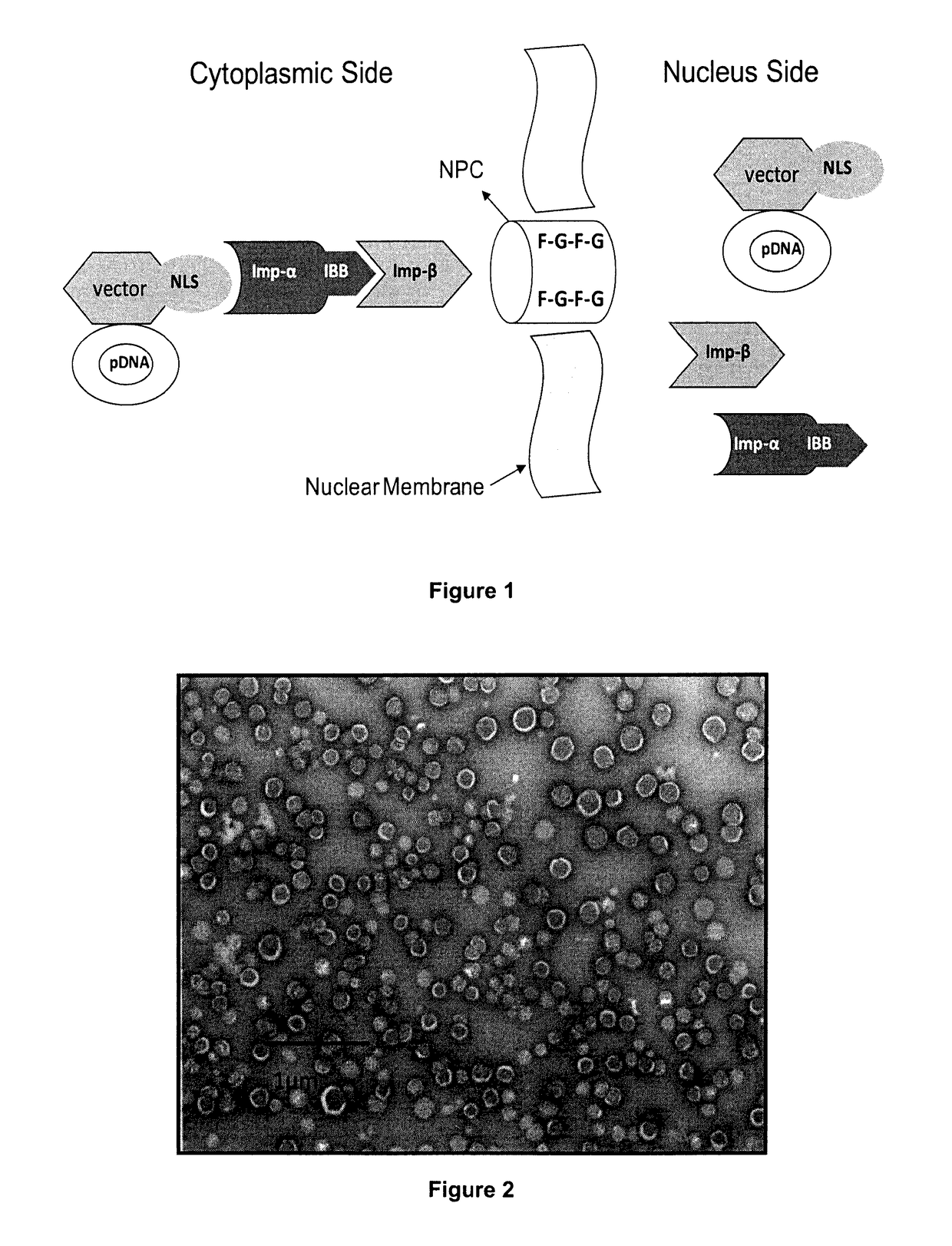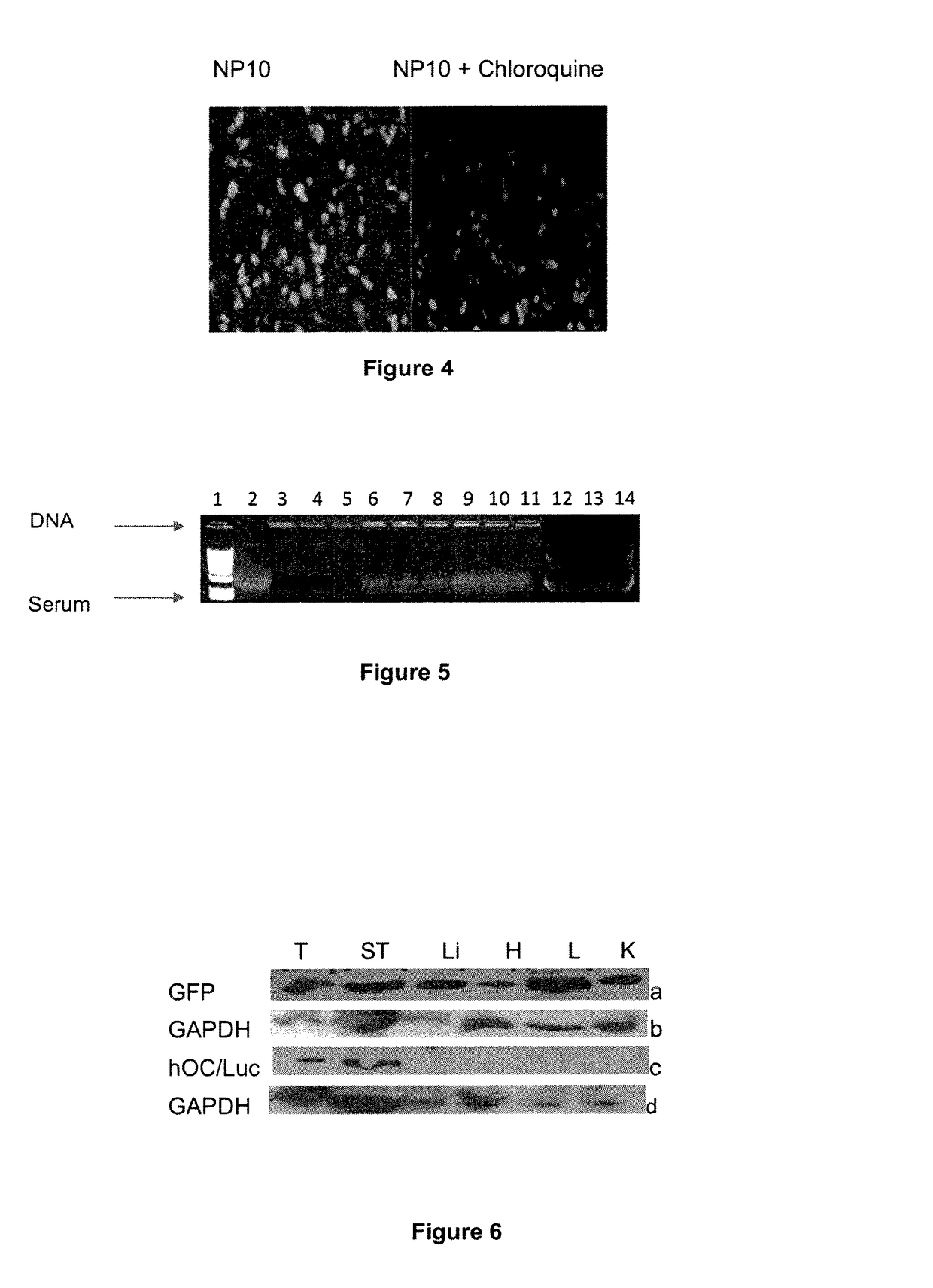Amphipathic peptide
a peptide and amphipathic technology, applied in the field of amphipathic peptides, can solve the problems of many barriers to effective delivery of therapeutic agents, impeded progress of gene therapy, and limited current availability of vectors, so as to improve the bioavailability of phosphate based drugs and improve the cellular uptake of gold
- Summary
- Abstract
- Description
- Claims
- Application Information
AI Technical Summary
Benefits of technology
Problems solved by technology
Method used
Image
Examples
example 1
n of RALA Peptide
[0169]The following peptide (called “RALA” herein) was synthesised commercially in accordance with conventional techniques with the amino acid sequence
[0170]
WEARLARALARALARHLARALARALRACEA
RALA arrives in a lyophilised form and is reconstituted with molecular grade water to a desired concentration, aliquotted out and stored at −20° C. until further use. An aliquot is then taken as needed and defrosted on ice.
example 2
and In-Vitro / In-Vivo Testing of RALA / SIRNA Nanoparticles
Materials and Methods
Calculation of N:P Ratio
[0171]DNA was complexed with either the RALA peptide at various N:P ratios (the molar ratio of positively charged nitrogen atoms to negatively charged phosphates in DNA). As the number of positive side-groups in a protein side chain depends upon the sequence, different proteins will have differing numbers of positive charges per unit mass. In order to calculate this, the following equation was used:
NP=Mprotein / MDNACNP
[0172]Where M protein is the mass of a protein, M DNA is the mass of DNA and C NP is the N:P constant. The N:P constant is the ratio of the protein's side chain positive charge density to the DNAs backbone density, with the charge density being the charge of a substance divided by its molecular mass. For the protein, lysine, arginine and histidine side groups are counted. For the DNA the average mass of one single base pair, and the charge of the phosphate group are use...
example 3
ve Peptide Sequences
[0251]The following peptide sequences based on RALA (WEARLARALARALARHLARALARALRACEA) were also prepared using conventional commercial techniques as expanded on in Example 1.
[0252]
TABLE 3Key Characteristics RALA (WEARLARALARALARHLARALARALRACEA) derivativePeptides in ZR-75-1 breast cancer cells determined in accordance with the protocols ofExample 2.CharacteristicsTransfectionLengthEfficiencyPeptideSEQ IDHydrophilic:HydrophobicBest SizeChargein ZR-75-1N:P10No.+ / −(nm)(mV)Cells1. Original130 mer702530%RALA30:67:18:22. Peptide 2229 mer762255(H Removed)31:707:23. Peptide 3430 mer512441(H Replaced33:67with E)7:34. Peptide 4529 mer371250(H Removed33:67and Replaced8:2W replaced withR)5. Peptide 5629 mer531346(H Removed37:63and W replaced9:2with R and Creplaced withR)6. Peptide 6730 mer308643(H Replaced40:60with E and W9:3replaced with Rand C replacedwith R)
Results
[0253]The results in terms of transfection efficiency in ZR-75-1 cells are shown in Table 3. Peptides 1-5 succ...
PUM
| Property | Measurement | Unit |
|---|---|---|
| pH | aaaaa | aaaaa |
| size | aaaaa | aaaaa |
| size | aaaaa | aaaaa |
Abstract
Description
Claims
Application Information
 Login to View More
Login to View More - R&D
- Intellectual Property
- Life Sciences
- Materials
- Tech Scout
- Unparalleled Data Quality
- Higher Quality Content
- 60% Fewer Hallucinations
Browse by: Latest US Patents, China's latest patents, Technical Efficacy Thesaurus, Application Domain, Technology Topic, Popular Technical Reports.
© 2025 PatSnap. All rights reserved.Legal|Privacy policy|Modern Slavery Act Transparency Statement|Sitemap|About US| Contact US: help@patsnap.com



